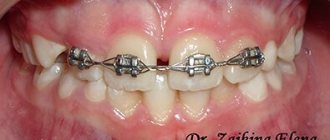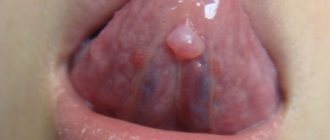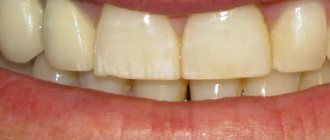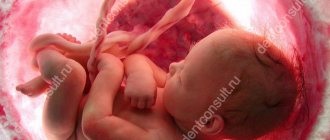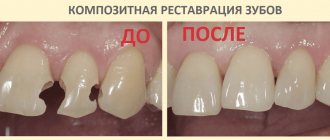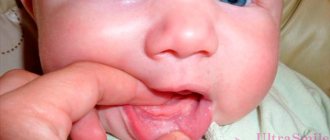Dental parallelometers
A dental laboratory uses equipment for cutting, grinding, sintering and fixing dentures, but without measuring instruments it is impossible to produce high-quality and comfortable dentures of the correct shape. A parallelometer is a device designed to determine undercuts and parallelism of the walls of abutment teeth, as well as to draw a survey line.
The device allows you to create artificial parallelism of teeth, choose the optimal direction for inserting the prosthesis and ensure reliable fixation of the clasps.
Clasp system
Currently, this system has become widespread both in our country and abroad in the manufacture of removable solid-cast structures. The basis was the fundamental research of Soviet and foreign scientists: A. M. Guzikova (1952), G. P. Sosnina (1966, 1971, 1981), A. D.
Schwartz (1968), D. N. Lipshits (1969), A. F. Spirin (1971), E. I. Gavrilov and E. N. Zhulev (1973), V. I. Kulazhenko and S. S. Berezovsky (1975), V. P. Panchokhi, V. P. Liniyka and A. N. Lensky (1975), V. P. Panchokhi (1981), N. W. Gil-let (1923, 1927), F. S. Roach (1929, 1930, 1934, 1945), A.
E1-brecht (1933, 1935), W. Baiters (1935), V. Bonyhard (1938, 1941), JM Ney (1948, 1949, 1952, 1965), etc. As a result of research, well-known systems and individual designs were created clasps, as well as their modifications (Roach, Balters, Ney, Gavrilov and Zhulev, Berezovsky, Acker, Bonneville, Reichelman, Jackson, De Van, Kennedy, Elbrecht, Elliott, etc.).
We suggest you read: Tooth hurts when pressed after root canal filling
When planning a removable structure, taking into account a number of factors, a specialist is each time faced with a difficult task, the exact solution of which determines the choice of the optimal type of clasp. As is known, the features of solid-cast structures require careful preliminary calculations for the exact location of the clasp on each abutment tooth.
The solution to this problem is facilitated by equipping dental clinics with parallelometers, which allow them to study models, select the optimal location of the line of sight, and also solve other problems. Knowledge of the purpose and properties of each of the elements of the support-retaining clasp is the basis for their correct location on the abutment tooth.
Fig. 16. Clasp fixation. a - overlay; b - body; c - stabilizing part; d — retention ending; d - clasp extension.
roll the line of sight and deviate from it depending on the elastic deformation of the alloy used, the type of clasp, determining the location of the end of the clasp arm, the endurance of the supporting teeth and many other factors. The standard size of the supporting teeth, their inclination and the curvature of the walls are also of great importance for the location of the retaining and supporting elements of the clasp, especially considering that only the retaining ends of the clasp have elasticity, and therefore the ability to pass through the convex sections of the tooth.
The placement of rigid, inelastic elements in the retaining areas is a gross mistake that prevents the application of the prosthesis on the jaw or contributes to the displacement of teeth and the occurrence of their mobility. Most often, errors in the arrangement of clasp elements and other parts of the frame are associated precisely with an underestimation of the surface of each supporting tooth or insufficient knowledge of materials science and the properties of cast structures.
It should be remembered that when a solid clasp is applied to an abutment tooth, a clasp-tooth system is formed. Its optimal functioning depends on many conditions, both from a biological and a purely technical point of view. However, when using a clasp fixation system, recommendations are often used that lead to errors in the manufacture of clasps.
Very often, in order to create a massive recess for an elongated occlusal overlay, the surface of two or three chewing cusps is ground and artificial crowns are made with a massive occlusal recess reaching the middle of the chewing surface of the tooth. In this case, we proceed from the data available in the literature about the absence of the tilting effect of the linings covering at least half of the
external surface of the tooth and transmitting loads parallel to its longitudinal axis [Kurlyandsky V. Yu., 1965; Osborne J., Lammie G., 1974, etc.]. However, as clinical observations show, after manufacturing and applying the prosthesis in accordance with the specified recommendations, elongated onlays, shaped like a wide wedge, partially or completely cover the masticatory fissures and internal slopes of the masticatory tuberosities. As a result, the chewing surface of premolars and molars is significantly flattened.
The studies we conducted together with E. L. Altunyan did not confirm the feasibility of making an elongated onlay and using it to eliminate the tilting effect of the chewing load on the tooth. In experimental models, in all cases without exception, we observed the departure of the end part of the elongated occlusal overlays from the surface of the tooth and the concentration of contact only in the area of connection of its chewing surface with the proximal one, i.e.
on the edge of the tooth. Deviation of the onlays from the chewing surface with terminal defects of the dentition was also accompanied by the formation of a gap of greater or lesser size. Considering the available data on the lower displacement of the abutment tooth (30-50 times) compared to the compliance of the mucous membrane, the insufficient validity of recommendations for the manufacture of an elongated onlay for the terminal defect of the dentition is obvious.
The information in the literature about the most appropriate shape of the occlusal recess and the angle of its inclination relative to the chewing surface of the teeth in the case of an onlay located on the side of the defect also indicates the irrationality and ineffectiveness of denture designs with elongated occlusal onlays [Shvarts S.D., 1968 ; Betelman A.I., 1974; Sosnin G.P., 1971, 1981, etc.].
We invite you to read: How many teeth can a person remove at one time? DentalMaster
To prevent the tilting effect, there are appropriate calculations and recommendations for designing a small overlay and placing it on the tooth surface distant from the defect (from the side of the adjacent tooth). The tilting effect of the load on the supporting tooth in this case is neutralized by the resistance of the adjacent tooth.
Due to the rigidity of cobalt-chromium alloys, the minimum length and thickness of the occlusal lining (within 3X2.5 mm) on most teeth is quite justified. This is of significant importance when choosing a site for placing the lining on the supporting surface of the tooth without disturbing the shape of its chewing surface.
The relief of the chewing surface in some cases favors the location of the occlusal overlay within the natural enamel fossa located on each side of the longitudinal chewing fissure. This does not require tooth preparation or disruption of the shape of its chewing surface. No less negative consequences are observed in cases of making an elongated onlay on the incisors or canines.
In this case, the oral wall is excessively modeled, creating a deep bed in the artificial crown that reaches the longitudinal axis of the tooth. As a result, the crown made for a canine takes on the shape of a premolar, and for an incisor - the shape of a fang, which contributes to the overload of these teeth. The optimal surface for preparing and modeling canines and incisors for an onlay is the area of the oral wall above the dental tubercle.
In many cases, the topography of the support zone is underestimated when making a continuous clasp on chewing teeth. The most typical mistake is the complete or partial location of the clasp in the retaining, or cervical, part of the tooth, i.e., under the line of sight, for example on the lower jaw.
An important point is the selection of the cross-section of the clasp elements. This is necessary to create sufficient rigidity of the lining, body and stabilizing part when transmitting chewing loads, as well as to achieve the elastic action of the retaining ends of the clasp arms.
In this regard, the use of elastic matrices (“For-Modent”, etc.) or the use of polymer clasp blanks produced by some foreign companies greatly simplifies and speeds up the modeling of clasps and other frame parts. The profile and cross-section of these blanks are calculated in advance taking into account the mechanical properties of chromium-cobalt alloys, which have different hardness and elasticity depending on their
chemical composition (“Viptam”, “Tioconium”, “Visil”, “Dentitan”, “Svedion”, “Duralium”, etc.).
S. D. Schwartz (1968) notes that the same matrix cannot be used for gold and chromium-cobalt alloys, given the need to obtain different sections of clasp elements in each case. Therefore, the best option in the manufacture of solid cast structures is the use of complexes that include a certain chromium-cobalt alloy and a corresponding set of blanks or matrix.
The use of matrices, as well as standard polymer blanks, nevertheless requires calculation and a thoughtful approach when modeling clasps and other frame parts from them. Very often there are technical errors associated with ignoring calculations of the radius of the clasp arm [Sosnin G.P.
, 1981] and incorrect placement of its retaining end. Instead of placing the latter at the retention point found during parallelometry, it is often placed on the line of sight, i.e., the greatest convexity of the tooth. Quite often, by analogy with a bent (wire) arm, the cast arm of a clasp is also given a Y-shape with its holding end brought into the support zone.
In these cases, fitting the finished clasp arm is accompanied by significant grinding of its inner surface and loss of fixing properties. The most common mistake is to cross the diagonally raised line of sight and place the rigid elements of the clasp (stabilizing part, body and process) in the retaining part of the tooth.
Such errors, oddly enough, are most often made in the manufacture of the well-known Acker clasp, which indicates the lack of a clear differentiation of the elements of each clasp into hard or inelastic, which in all cases without exception should be located in the support zone, and springy ones, which should be in the containment zone.
Only the latter, as noted by V.N. Kopeikin (1977), can cross the line of sight and end at the retention point. The different sizes of the crown part of the teeth (type variants) are also ignored. As a result, the application of large standard blanks on small teeth, as already noted, often leads to an unreasonable Y-shaped bend of the shoulder and the removal of its end through the line of sight into the support zone. Overlay dimensions (length and width)
Tags: orthopedic, parallelometry, dentistry
« Previous entry
What does the device look like?
Modern equipment for measuring parallelism is installed on dental milling machines, which significantly increases the quality and accuracy of milling work. The cost of the device depends on the manufacturing company, ergonomics, functional equipment, and year of manufacture.
The device consists of a stand with a movable bracket, on which instruments for measuring dentures and cutting wax are mounted, and a flat working surface. There are several configuration options: with a movable clamp, a movable table, a fixed stand connected to the frame.
For convenient work with models, a replaceable set of rods is provided. The following types of rods are distinguished:
- to determine the survey line;
- for measuring work;
- for drawing survey lines;
- blades for cutting off excess wax.
The device body is assembled from aluminum parts. This approach allows us to achieve the necessary margin of strength and wear resistance, while ensuring low weight. Polymer spray coating provides electrostatic protection.
Model testing process
The finished model of the jaw is sent to the parallelometer table, where it is fixed. Then follows the stage of studying the retaining points of the dental elements. After which the modeled jaw is directed to the analyzing rod of the device. The final stage involves scrolling the instrument table in different directions. This manipulation is explained by the fact that it is necessary to find the correct position of the jaw so that the angle (determined by a parallelometer) is necessarily parallel to the retention surface of the clasps of the dental elements.
Clasp prosthesis with locks
Then the conditions are created to determine the location of the clasp arm (characterized by the holding function). The parallelometer table should be fixed in this position. Next comes the outline of the belt, which is done using a graphite rod.
The belt, located on the dental elements, which is responsible for the chewing function, must pass through all contact points on each side. Thus, there is a common belt line, which makes it possible to determine the location of the support-retaining clasps. It is impossible to determine their location in advance; therefore, through the use of gauges, the severity of the retention surface is determined. After completing all of the above manipulations, you need to determine the type of design of the fixing bracket.
Rules of parallelometry
Where to buy an inexpensive parallelometer
Finding a cheap dental device is not an easy task. Dental equipment is expensive, as it belongs to the category of complex equipment. If you do not want to overpay, we recommend purchasing a working used device. You can find suitable equipment for a dental laboratory on the pages of the BiMedis service, a leading online platform for the purchase and sale of medical equipment.
BiMedis has brought together sellers and buyers from all over the world. Anyone can post a sale advertisement: both legal entities and individuals. To choose the option that best suits your budget, use a special filter. The system allows you to sort search results by the following criteria: price, year of manufacture, product location, type (new, used, refurbished), device model. It is possible to exchange personal messages to agree on the details of the transaction.
If you want to sell medical equipment, post your own ad! The feature is provided free of charge.

